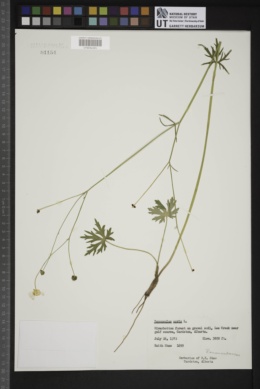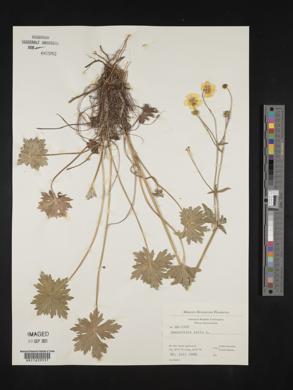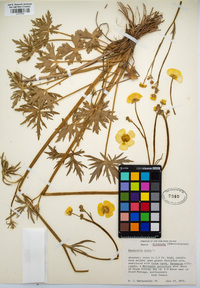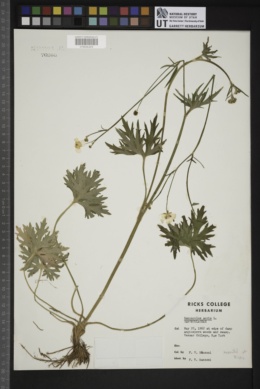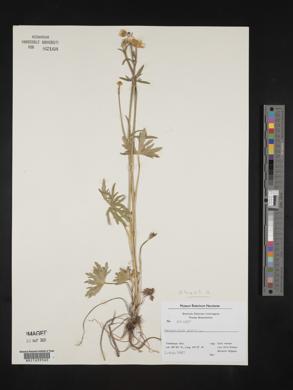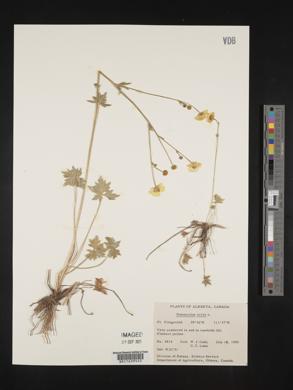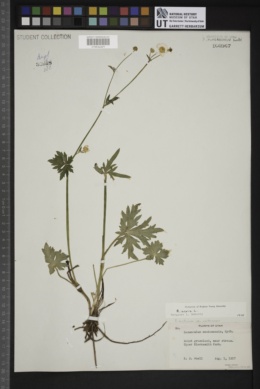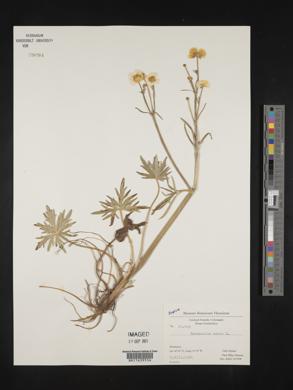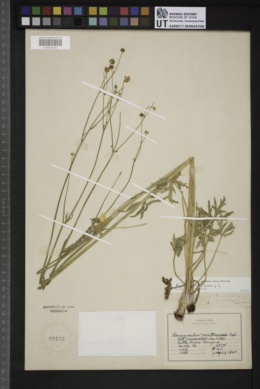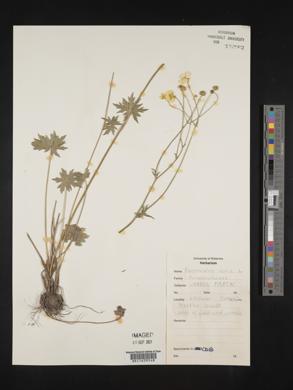Ranunculus acris
|
|
|
|
Family: Ranunculaceae
Tall Buttercup, more...meadow buttercup
|
Stems erect from short caudex or rhizome, never rooting nodally, hispid, strigose, or glabrous, base not bulbous. Roots never tuberous. Basal leaf blades pentagonal in outline, deeply 3-5-parted, 1.8-5.2 × 2.7-9.8 cm, segments 1-2×-lobed or -parted, ultimate segments narrowly elliptic or oblong to lanceolate, margins toothed or lobulate, apex acute to rounded. Flowers: receptacle glabrous; sepals spreading, 4-6(-9) × 2-5 mm, hispid; petals 5, yellow, 8-11(-17) × 7-13 mm. Heads of achenes globose, 5-7(-10) mm wide; achenes 2-3 × 1.8-2.4 mm, glabrous, margin forming narrow rib 0.1-0.2 mm wide; beak persistent, deltate, usually with tip short or long, straight or curved, subulate, 0.2-1 mm. 2 n = 14. Flowering spring-summer (May-Sep). Meadows, stream banks, roadsides, and old fields; 0-2300 m; largely introduced; Greenland; St. Pierre and Miquelon; Alta., B.C., Man., N.B., Nfld., N.W.T., N.S., Ont., P.E.I., Que., Sask.; Ala., Alaska, Ariz., Calif., Conn., Del., D.C., Ga., Idaho, Ill., Ind., Iowa, Kans., Ky., Maine, Md., Mass., Mich., Minn., Mo., Mont., Nebr., Nev., N.H., N.J., N.Y., N.C., N.Dak., Ohio, Oreg., Pa., R.I., S.C., S.Dak., Tenn., Utah, Vt., Va., Wash., W.Va., Wis., Wyo.; South America; Eurasia; Pacific Islands; Australia. Ranunculus acris is variable in form and division of leaves, size of achene beak, and form of indument on the proximal stem. Most North American plants are weedy and have poorly differentiated caudices; these forms probably were introduced from Eurasia. Rhizomatous plants with large flowers (parenthetic measurements above) found in the Aleutian Islands of Alaska and in Greenland are probably native. Aleutian populations of this form have been called R . acris var. frigidus Regel or R . grandis Honda var. austrokurilensis (Tatewaki) H. Hara. Both names were originally applied to Asiatic plants, and their applicability to American specimens is open to question. Some Native American tribes used Ranunculus acris as an analgesic, a dermatological or oral aid, an antidiarrheal, antihermorrhagic, and a sedative (D. E. Moerman 1986).
Spreading-hairy perennial, slender, eventually to 1 m, leafy mostly below the middle, the long branches with few, widely separated, much reduced lvs; lvs reniform, deeply 3-cleft, the broadly cuneate-obovate segments incised or cleft into oblong or linear lobes; pet broadly obovate, often retuse, 8-16 mm, twice as long as the sep; achenes in a subglobose head, flat, margined, broadly and obliquely obovate, 2-3 mm, the beak 0.4-1 mm; 2n=14, 28, 29, 32. Native of Europe, widely introduced in N. Amer. as a weed in fields and meadows and along roadsides. May-Sept. Double-flowered forms occur. Gleason, Henry A. & Cronquist, Arthur J. 1991. Manual of vascular plants of northeastern United States and adjacent Canada. lxxv + 910 pp. ©The New York Botanical Garden. All rights reserved. Used by permission. From Flora of Indiana (1940) by Charles C. Deam This species has been reported from eight counties, mostly northern. It is local along railroads and roadsides. I have seen it abundant in a few places, and in time no doubt it will become a weed in favorable habitats. My Allen County specimen, no. 47063, is exceptional in that the blades of the stem leaves are divided into three parts and these are on petiolules 0.5-3 cm long. …… Indiana Coefficient of Conservatism: C = null, non-native Wetland Indicator Status: FAC |
|
|
|

















